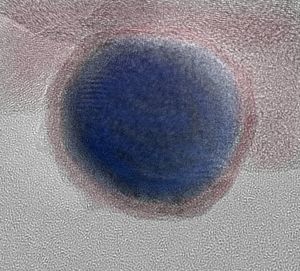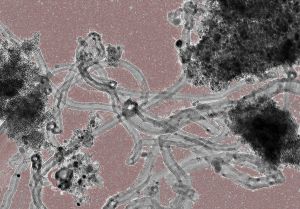Development of high-performance energy stores presently is one of the biggest challenges of research, as they are the prerequisite for the economic efficiency of future electromobility and for the integration of renewable energies in the energy system. As regards batteries, it is worked on increasing the performance, sustainability, and safety. At the Institute of Nanotechnology of Karlsruhe Institute of Technology (KIT), a completely novel approach to battery architecture and use of materials has now been developed, which promises enormous improvements in terms of the amount of energy stored and costs. This new approach might considerably increase the cruising range of electric cars in the long term.
According to the state of the art, the amount of energy stored in a battery is smaller by a factor of 50 than the energy in a fuel tank of the same size. “Use of conventional lithium-ion battery materials is expected to allow for slight improvements only,” says Dr. Maxi-milian Fichtner, Head of the Energy Storage Group of the KIT Insti-tute of Nanotechnology. To considerably enhance the performance, it was therefore necessary to develop completely new approaches to both the development of materials and battery architecture.
Fichtner and his team focused on entirely new iron-carbon materials, by means of which far more energy can be stored on smallest space. The problem: The materials described so far do not have any cyclic stability and storage capacity decreases rapidly, if the battery is charged and discharged repeatedly.
The KIT Institute of Nanotechnology has therefore developed a new approach to the synthesis of iron-carbon storage materials. By means of the process, the patent of which has been applied for, metal organic materials are mixed with a lithium salt and heated up. As a result, an entirely new nanostructure with simultaneously de-veloping carbon wires forms. Nanoscaled storage units and conduction paths are generated quasi in one step.

Iron nanoparticle. (Photo: INT)
The specific capacity of the new cathode material, i.e. its capability of storing energy, already is about twice that of current batteries. “This is the first example worldwide of a stable conversion material, by means of which far more electrons and lithium can be “packed” on small space than by conventional methods,” underlines Fichtner. ”Production is simple and inexpensive and the high capacity of the iron-carbon electrode is maintained for a long time. This is an enor-mous progress compared to materials used so far. If we succeed in fully exhausting the potential of this new material, we can improve the storage density of lithium-ion batteries by the factor of 5,” says Fichtner.
In close partnership with society, KIT develops solutions for urgent challenges – from climate change, energy transition and sustainable use of natural resources to artificial intelligence, sovereignty and an aging population. As The University in the Helmholtz Association, KIT unites scientific excellence from insight to application-driven research under one roof – and is thus in a unique position to drive this transformation. As a University of Excellence, KIT offers its more than 10,000 employees and 22,800 students outstanding opportunities to shape a sustainable and resilient future. KIT – Science for Impact.

